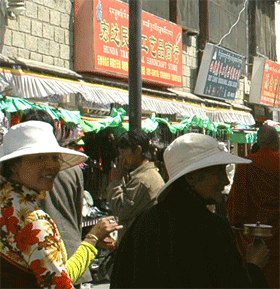Bakhor Street
 Bakhor, also named as Baghor, is the oldest street in Lhasa. In the past, it was only a circumambulation circuit, “a saint road ” in the eyes of Tibetan. Now it’s also a shopping center with nation characteristics. It’s an old district with colorful Tibetan features. Tibetan houses line the street, and the ground is paved with man-made flagstones, preserving the ancient look. In the street, you can find satisfactory souvenirs, and experience the mysterious “one step one kowtow” faith to religion.
Bakhor, also named as Baghor, is the oldest street in Lhasa. In the past, it was only a circumambulation circuit, “a saint road ” in the eyes of Tibetan. Now it’s also a shopping center with nation characteristics. It’s an old district with colorful Tibetan features. Tibetan houses line the street, and the ground is paved with man-made flagstones, preserving the ancient look. In the street, you can find satisfactory souvenirs, and experience the mysterious “one step one kowtow” faith to religion.
All the houses along the street are stores. All kinds of fantastic commodities show us all aspects of the Tibetan life. Such as: Thangkas, copper Buddha, prayer wheels, butter lamps, prayer flags with sutras, beads, Tibetan joss sticks, cypress, etc. Household goods in shops are in abundant, such as: cushion, Pulu, aprons, leather bag, harness, snuff bottles, steels, Tibetan-style quilts, Tibetan-style shoes, clasp knives, Tibetan-style hats, butter, butter pots, wooden bowls, Highland Barley Wine, sweet milk tea, milk residue, air-dried beef and mutton, etc. All kinds of tourist products, cheap but good, can be found in the 1,000-meter-long street.
Bakhor Street is a human landscape miniature of Lhasa, even in the whole Tibet. The old circumambulation circuit is always crowded with pilgrims from everywhere. Some come along the road by performing the body-long kowtows, some come by truck. Some are monks, and some are businessmen from Kham. In a word, here you will find people from all over Tibet. You can enjoy different dresses, and languages. Even the similar-looking dresses of the monks vary depending on the different religions. Bakhor Street is the window to view the Tibetan area, which is silently telling the history of Lhasa.
In the Barkhor street area, there are a lot of private small Thangka workshops. Stop in any one of them and watch the artists work. Visitors are welcome to ask questions.
Evaluation: the Magyia Ngami Restaurant can best reflect the civilian culture of Lhasa
Recommendation index: ☆☆☆☆
History
Bakhor Street was first a circumambulation circuit around the Jokhang Temple. According to Lamaism_(Tibetan Buddhism), circumambulation means walking around the Jokhang Temple in the clockwise direction, which shows worship to the Bronze statue of Sakyamuni enshrined in the temple. It is one of the three famous circumambulation circuits in Lhasa. An endless flow of worshippers every day proved it the famous one in Lhasa.
In addition, there are two more circumambulation circuits chiming with it. One is the Linkhor (outer circumambulation circuit) around the old city zone containing the Potala Palace; the other is the mysterious “Rangkor”, which is the circumambulation corridor inside the Jokhang Temple.
The three circumambulations circuits give witness and maintain the vital position of the Jokhang Temple. The temple is not only a palace where the Buddha Bronze statue and holly articles are offered, but also the reflection of the Esoteric Buddhism about the ideal of universe, namely the Mandala. Now Bakhor Street refers to a larger area including the entire district around the Jokhang Temple, which is the well-preserved old city zone.
Legend
In the Bakhor Street, there is a place, which the visitors can’t miss: the Magyia Ngami Restaurant. Most of the buildings in the street are white, except the yellow two-story one at the southeastern corner of Barkor Street. It was the secret palace of the 6th Dalai Lama Cangyand Gyamco. There he wrote the famous poem From the top of high mountains in the east, “Whenever the bright moon rose, From the top of high mountains in the east, the pretty young girl’s face, rises in my mind。” “Pretty young girl” means Magyia Ngami in Tibetan. Now the Magyia Ngami Restaurant is a bar with a good taste of art. On its wall hang works of painting, photograph, and handicraft and on the shelf there are original edition of works by Kafka and Eliot.
1. Direction: Walk in the clockwise direction in the in the Bakhor street
2. Time : Don’t stroll in the Bakhor Street too late. Every day after 6 o’clock the Bakhor Street will turn to a fair trade market, mainly selling small articles of everyday use. And there are many narrow lanes and side roads along the street, you may easily get lost in the dark.
3. Second-hand goods : For some unknown reasons, the stall keepers in the Bakhor Street firmly believe that second-hand goods can be sold at a high price, so they will show you new articles while telling you they are second-handed. In fact, that’s only a way of deciding the value, which will not indicate any problem about their judgment.
4. Bargain : When shopping in the Bakhor Street, visitors shall learn to bargain with the stall keepers. The stall keepers will charge quite differently for the same article, usually by ten times. Don’t make the final decision before inquiring several shops. The quality of the same goods differ greatly, especially the Dzi Beads from Heaven.
5. Discounts : According to the ancient customs, every day the Tibetan stall keepers will offer discounts to the first and the last buyers. Besides, the stall keeper will tap the money, charged from the buyers, on the goods as a way of inviting the God of Wealth